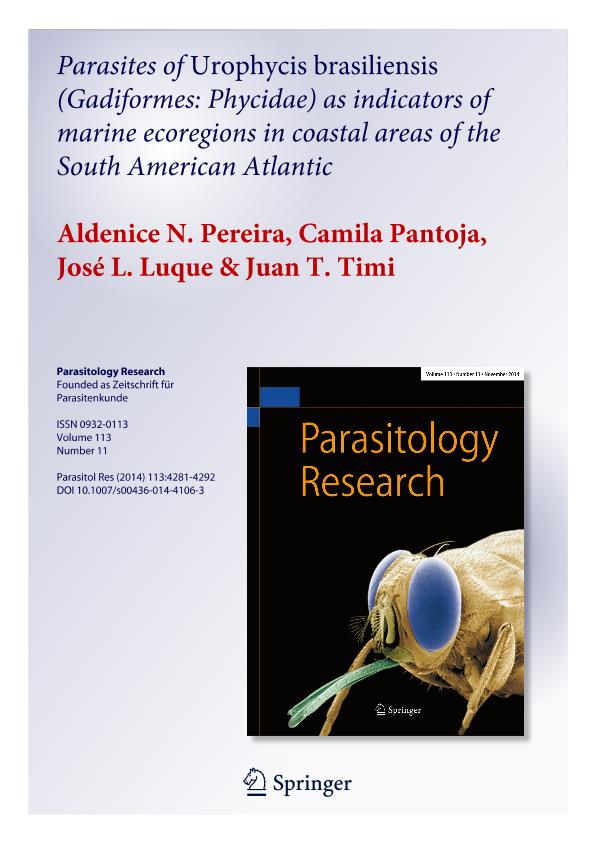Mostrar el registro sencillo del ítem
dc.contributor.author
Pereira, Aldenice
dc.contributor.author
Pantoja, Camila
dc.contributor.author
Luque, Jose L.
dc.contributor.author
Timi, Juan Tomas

dc.date.available
2018-01-31T19:43:29Z
dc.date.issued
2014-10
dc.identifier.citation
Pereira, Aldenice; Pantoja, Camila; Luque, Jose L.; Timi, Juan Tomas; Parasites of Urophycis brasiliensis (Gadiformes: Phycidae) as indicators of marine ecoregions in coastal areas of the South American Atlantic; Springer; Parasitology Research; 113; 11; 10-2014; 4281-4292
dc.identifier.issn
0932-0113
dc.identifier.uri
http://hdl.handle.net/11336/35283
dc.description.abstract
The potential value of parasites as ecosystem markers was tested by analyzing the metazoan assemblages of Urophycis brasiliensis caught in four locations distributed in three ecoregions of the Warm Temperate Southwestern Atlantic. A total of 5,001 metazoan parasites belonging to 33 species were found. The identified parasites varied across locations in terms of presence, prevalence, and abundance, and their multivariate analyses resulted in clear similarity patterns. No differences were observed between two locations of the same ecoregion, whereas an evident separation of samples was observed across ecoregions in support of the existing hypotheses regarding the ecoregional division of the southwestern Atlantic. We proposed that parasite assemblages, which are composed of several metazoan phyla, are potentially useful as ecosystem indicators. This suggestion is derived from the combined evidence of the evolutionary history and biogeography of multiple lineages, which is expected to be more efficient in capturing recurrent patterns in overall biodiversity than individual lineages. Furthermore, as many parasites have complex life cycles, their distribution patterns are dependent not only on environmental conditions but also on the distribution and population density of all hosts involved in their life cycles, adding further sources of distributional variability that act synergistically to define robust geographical patterns. The selection of long-lived parasites and their comparative analysis provided evidence supporting the existence of three different stocks in the four sampled areas. The best parasite tags were those with low specificity in fish hosts, constituting promising biological tags for the stock discrimination of other fish species in the region.
dc.format
application/pdf
dc.language.iso
eng
dc.publisher
Springer

dc.rights
info:eu-repo/semantics/openAccess
dc.rights.uri
https://creativecommons.org/licenses/by-nc-sa/2.5/ar/
dc.subject
Biological Tags
dc.subject
Parasites
dc.subject
Urophycis Brasiliensis
dc.subject.classification
Otras Ciencias Biológicas

dc.subject.classification
Ciencias Biológicas

dc.subject.classification
CIENCIAS NATURALES Y EXACTAS

dc.title
Parasites of Urophycis brasiliensis (Gadiformes: Phycidae) as indicators of marine ecoregions in coastal areas of the South American Atlantic
dc.type
info:eu-repo/semantics/article
dc.type
info:ar-repo/semantics/artículo
dc.type
info:eu-repo/semantics/publishedVersion
dc.date.updated
2018-01-26T18:56:50Z
dc.journal.volume
113
dc.journal.number
11
dc.journal.pagination
4281-4292
dc.journal.pais
Alemania

dc.journal.ciudad
Berlin
dc.description.fil
Fil: Pereira, Aldenice. Universidade Federal Rural do Rio de Janiero; Brasil
dc.description.fil
Fil: Pantoja, Camila. Universidade Federal Rural do Rio de Janiero; Brasil
dc.description.fil
Fil: Luque, Jose L.. Universidade Federal Rural do Rio de Janiero; Brasil
dc.description.fil
Fil: Timi, Juan Tomas. Consejo Nacional de Investigaciones Científicas y Técnicas. Centro Científico Tecnológico Conicet - Mar del Plata. Instituto de Investigaciones Marinas y Costeras. Universidad Nacional de Mar del Plata. Facultad de Ciencia Exactas y Naturales. Instituto de Investigaciones Marinas y Costeras; Argentina
dc.journal.title
Parasitology Research

dc.relation.alternativeid
info:eu-repo/semantics/altIdentifier/doi/http://dx.doi.org/10.1007/s00436-014-4106-3
dc.relation.alternativeid
info:eu-repo/semantics/altIdentifier/url/https://link.springer.com/article/10.1007%2Fs00436-014-4106-3
Archivos asociados
